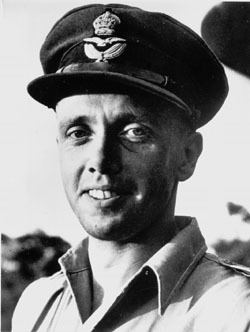Allegiance United Kingdom Name David Lord Rank Flight Lieutenant | Years of service 1936-1944 † Service/branch Royal Air Force | |
 | ||
Born 18 October 1913
Cork, Ireland ( 1913-10-18 ) Died 19 September 1944 (1944-09-20) (aged 30)
Arnhem, Netherlands Buried at Arnhem Oosterbeek War Cemetery | ||
David Samuel Anthony Lord VC, DFC (18 October 1913 – 19 September 1944) was an Irish recipient of the Victoria Cross, the highest and most prestigious award for gallantry in the face of the enemy that can be awarded to British and Commonwealth forces.
Contents

Early life
David Lord was born on 18 October 1913 in Cork, Ireland, the son of Samuel (a Warrant Officer in the Royal Welsh Fusiliers) and Mary Lord.
After the First World War the family were posted to British India and Lord attended Lucknow Convent School. On his father's retirement from the Army the family moved to Wrexham and then David was a pupil at St Mary's College, Aberystwyth before attending the English Ecclesiastical College, Valladolid, Spain to study for the priesthood. Deciding the priesthood was not the career for him he returned to Wrexham before moving to London in the mid-1930s as a freelance writer. He enlisted in the RAF in 1936.
Second World War
He underwent pilot training, becoming a Sergeant Pilot in 1939 with No. 31 Squadron RAF on the North West Frontier, flying the Vickers Valentia biplane. In 1941 No. 31 squadron was the first unit to receive the Douglas DC-2 which was followed by both the Douglas DC-3 and Dakota transports. He flew in the Middle East, (being injured in a crash) before being posted back to India. Commissioned in 1942, he flew on supply missions over Burma.
Lord was awarded the Distinguished Flying Cross during 1943 and by January 1944 had returned to the UK for service with No. 271 Squadron (based at RAF Down Ampney, Gloucestershire) training to drop paratroops, supplies and to tow military gliders. He then took part in the D-Day operations in June 1944.
Battle of Arnhem
The Battle of Arnhem was part of Operation Market Garden, an attempt to secure a string of bridges through the Netherlands. At Arnhem the British 1st Airborne Division and Polish 1st Independent Parachute Brigade were tasked with securing bridges across the Lower Rhine, the final objectives of the operation. However, the airborne forces that dropped on 17 September were not aware that the 9th SS and 10th SS Panzer divisions were also near Arnhem for rest and refit. Their presence added a substantial number of Panzergrenadiers, tanks and self-propelled guns to the German defences and the Allies suffered heavily in the ensuing battle. Only a small force managed to hold one end of the Arnhem road bridge before being overrun on the 21st. The rest of the division became trapped in a small pocket west of the bridge and had to be evacuated on the 25th. The Allies failed to cross the Rhine, which remained under German control until Allied offensives in March 1945.
Resupply flights
He was 30 years old, and a Flight Lieutenant in 271 Squadron, Royal Air Force during the Second World War when the following deed took place for which he was awarded the Victoria Cross.
On 19 September 1944 during the Battle of Arnhem in the Netherlands, the British 1st Airborne Division was in desperate need of supplies. Flight Lieutenant Lord, flying Dakota III KG374 through intense enemy anti-aircraft fire was twice hit and had one engine burning. He managed to drop his supplies, but at the end of the run found that there were two containers remaining. Although he knew that one of his wings might collapse at any moment he nevertheless made a second run to drop the last supplies, then ordered his crew to bail out. A few seconds later the Dakota crashed in flames with its pilot and six crew.
Only the navigator, F/Lt Harold King survived, becoming a prisoner of war. It was only on his release in mid 1945 that the story of Lord's action was known, and David Lord was awarded a posthumous Victoria Cross. David Lord is buried alongside his crew in Arnhem Oosterbeek War Cemetery, near Arnhem.
Victoria Cross
The full citation for Lord's VC appeared in a supplement to the London Gazette on 9 November 1945, reading:
Air Ministry, 13 November 1945.
The KING has been graciously pleased to confer the VICTORIA CROSS on the undermentioned officer in recognition of most conspicuous bravery:—
Flight Lieutenant David Samuel Anthony LORD, D.F.C. (49149), R.A.F., 271 Sqn. (deceased).
Flight Lieutenant Lord was pilot and captain of a Dakota aircraft detailed to drop supplies at Arnhem on the afternoon of the 19th September, 1944. Our airborne troops had been surrounded and were being pressed into a small area defended by a large number of anti-aircraft guns. Air crews were warned that intense opposition would be met over the dropping zone. To ensure accuracy they were ordered to fly at 900 feet when dropping their containers.
While flying at 1,500 feet near Arnhem the starboard wing of Flight Lieutenant Lord's aircraft was twice hit by anti-aircraft fire. The starboard engine was set on fire. He would have been justified in leaving the main stream of supply aircraft and continuing at the same height or even abandoning his aircraft. But on learning that his crew were uninjured and that the dropping zone would be reached in three minutes he said he would complete his mission, as the troops were in dire need of supplies.
By now the starboard engine was burning furiously. Flight Lieutenant Lord came down to 900 feet, where he was singled out for the concentrated fire of all the anti-aircraft guns. On reaching the dropping zone he kept the aircraft on a straight, and level course while supplies were dropped. At the end of the run, he was told that two containers remained.
Although he must have known that the collapse of the starboard wing could not be long delayed, Flight Lieutenant Lord circled, rejoined the stream of aircraft and made a second run to drop the remaining supplies. These manoeuvres took eight minutes in all, the aircraft being continuously under heavy anti-aircraft fire.
His task completed, Flight Lieutenant Lord ordered his crew to abandon the Dakota, making no attempt himself to leave the aircraft, which was down to 500 feet. A few seconds later, the starboard wing collapsed and the aircraft fell in flames. There was only one survivor, who was flung out while assisting other members of the crew to put on their parachutes.
By continuing his mission in a damaged and burning aircraft, descending to drop the supplies accurately, returning to the dropping zone a second time and, finally, remaining at the controls to give his crew a chance of escape, Flight Lieutenant Lord displayed supreme valour and self-sacrifice.
Legacy
After Arnhem was liberated in April 1945, Grave Registration Units of the British 2nd Army moved into the area and began to locate the Allied dead. Lord was buried alongside his crew in the Arnhem Oosterbeek War Cemetery. There are many plaques in memory of him, including one at Wrexham Cathedral in Wales.
Several aircraft have carried tributes to Lord. Between 1993 and 1998, the RAF Battle of Britain Memorial Flight's Dakota, serial 'ZA947', was painted in the colours of Lord's aircraft during the Arnhem campaign, and bore the same code letters; YS-DM. Between 1973 and 2005, the Dakota displayed at RAF Museum Cosford was similarly painted and coded to represent Lord's aircraft. From 1966 until its disbandment in 2005, No. 10 Squadron RAF was equipped with Vickers VC-10s, each of which was named after a Royal Air Force or Royal Flying Corps VC recipient. Aircraft serial number 'XR810' was named David Lord VC.
